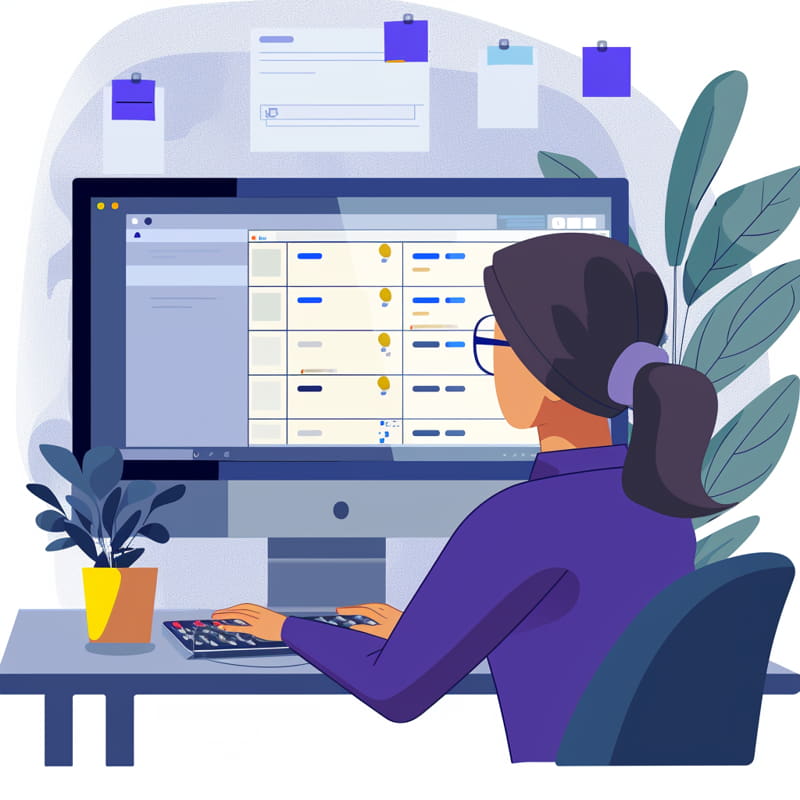SAP TM Training | Learn SAP TM Course
Introduction to SAP TM
The SAP Supply Chain Management (SCM) software suite includes SAP Transportation Management (SAP TM), one of its components.
Regarding logistics and transportation, it’s a one-stop shop for management.
Planning, executing, and settling freight are all areas where SAP TM shines. It helps businesses streamline their transportation operations, which in turn lowers costs and boosts customer satisfaction.
AP TM is compatible with any form of transportation, whether it be by road, train, air, or sea. It also offers integration with third-party systems and other SAP modules including SAP ERP, SAP EWM, and SAP GTS.

Steps in the SAP TM Process
There are four stages to the accelerated SAP methodology: planning, prototyping, implementation, and handoff.
In an expedited SAP project, the steps after project preparation are blueprinting, realization, and cut-over. The focus here is on the theoretical underpinnings of the various methodologies, as opposed to merely the system’s operational details.
Preparation, resource deployment, and activity management are all part of the project preparation phase.
Project schedule estimation, resource and work hour definition, and functional or technical issue handling are all part of it.
All parts of the project are addressed in this phase in a typical waterfall methodology.
Workshops with the client to understand the business processes needed to map into the system are the first step in the recommendation-gathering and blueprinting phase.
At this stage, we figure out if the system will be RTM, S4R, or standalone, and we help the customer choose the best fit for their business model.
Before beginning a project, it is necessary to complete the blueprinting step, which entails researching and documenting the company’s operations.
Tasks including development, testing, configuration, and actual project work kick off the realization phase.
The collecting phase addresses the holes in the system that were identified during the blueprinting phase.
During this stage, various office tools, such as workflow forms and interfaces, are developed.
Testing is an essential aspect of the realization process since it entails designing the system and testing the configuration extensively.
An essential component of every successful project is its go-live and support phase, which occurs in the project’s last phase.
In the testing process, there are self-phases such as functional need testing and integration testing, which check the solution’s foundations.
The development environment is where functional testing takes place, whereas integration testing is concerned with checking the EES (interfaces) that connect different parts of the system.
Importantly, the vendor firm handles the system while the client tests the solution via user access testing (UAT).
If any additional changes, such as issues or gaps found during UAT or SIT, are introduced, regression testing will detect them.
As part of this testing, you’ll need to make some modifications to the configuration or code, push them to the quality environment, and then see how different scenarios react to them.
The last step involves doing things like uploading, replicating, and getting ready for cut-over that pertains to master data.
Data delivered back to the production environment during cut-over operations may differ from the original master data.
Cut-over operations can result in the local creation of number ranges in the production environment.
Transportation management system fundamental operations
Essential for recording and handling faults in the transportation management system are basic activities. Interfaces with users, message configuration, and application logs are all part of these features.
An error and running message with a detail level of nine should indicate the severity of the error. All messages presented in the user interface are captured at the highest level of the data log, which is blind.
Determining the business system’s logical structure and defining it are two further sets of preparatory tasks. Within the HR master data, the HR staff will manage this integration.
Another critical area of preparedness is organizational management, which involves activating integration with business partners. This guarantees that the HR integration is enhanced so that transactions can be facilitated through the HR navigation.
The game makes use of organizational units in a variety of contexts, including component codes and touchpoints. The most fundamental organizational unit is the component code, and the associated transactions or applications are shown by the touch points.
Benefits of SAP TM (SAP Transportation Management):
Better transportation planning and optimization: SAP TM offers sophisticated algorithms to optimize transportation plans, considering variables like time, money, and capacity.
Transport expenses, service levels, and overall business efficiency can all be enhanced in this way.
Control and visibility in real-time: SAP TM allows for cargo tracking and monitoring in real-time, letting businesses spot and fix problems as soon as they emerge. Customer service and the likelihood of interruptions are both improved by this.
Settlement of freight automatically: SAP TM offers solutions for handling freight bills, such as automated payment processing and matching of invoices to shipments and carriers. In the long run, this can help businesses save effort and cut down on mistakes.
For a streamlined end-to-end supply chain solution, SAP TM can be connected with other SAP modules including SAP ERP, SAP EWM, and SAP GTS. As a result, businesses can save time and effort by not having to enter and reconcile data manually.
Mobility: Logistics workers, including drivers and dispatchers, can access real-time information and complete jobs on the go with SAP TM’s mobile apps. Productivity and reactivity can both be enhanced with this.
Flexibility and scalability: SAP TM can be easily modified to match the unique requirements of any business. It is flexible in terms of deployment, working with both on-premise and cloud environments, and in terms of integration with other systems.
Companies can make better decisions regarding logistics and transportation operations with the help of SAP TM’s real-time data and analytics. Efficiency, cost-effectiveness, and service quality can all be enhanced in this way.
Prior knowledge of the following is required to enrol in SAP Transportation Management (SAP TM) classes:
For taking up the SAP TM online class prior knowledge of transportation management principles and best practices is beneficial when learning SAP TM, as it will lay the groundwork for comprehending the system’s features.
Since SAP TM is based on the SAP NetWeaver platform and follows SAP’s UI and navigation conventions, it helps to have some experience with SAP software.
Before diving into SAP TM, it’s helpful to have a basic grasp of logistics and supply chain management ideas. This is because SAP TM is part of the SAP Supply Chain Management (SCM) software suite.
You can’t learn SAP TM without access to the program, so make sure you have it. One way to accomplish this is through a SAP education partner’s training environment, or the company’s own SAP system.
Resources for training: Documentation, manuals, and tutorials are all useful resources that can aid in the learning process.
Investing a lot of time and energy into learning SAP TM is essential. You should allocate sufficient time to finish the training and get comfortable with the software.

SAP TM Training

SAP TM Tutorial
Agile Methodology for SAP
A more adaptable and robust way to implement solutions is the agile approach. The product is defined during the project preparation phase, which involves using SAP Activate methodology to identify the product’s needs, interfaces, and challenges.
In the explore phase, the solution is subsequently developed and tested.
A gap fit analysis is carried out during the exploration phase to guarantee that the business processes are compatible with the standard solution. A model company product, a SAP lower environment, is used for this purpose.
With the help of the model company’s products, companies can design their processes and see if they meet the customer’s recommended standards.
Small adjustments can be made to accommodate the business process into the standard product if there are any gaps.
As part of the explore phase, SAP recommends doing a gap fit workshop to check if the business processes are compatible with the standard solution. To ascertain whether it conforms to the standard configuration, this will entail demonstrating the business process and the solution in action.
Following the exploration phase, the data about the business processes that are compatible with the system and those that are not is compiled, and a determination regarding the standard configuration is reached.
Development, testing, and solution configuration make up the usual realization process. A cut-over and deployment phase characterize this procedure, which is comparable to SAP’s waterfall method.
If there are any problems after going live, the implementation vendor can be notified quickly using post-go-live support or Hypercar.
The idea behind HBL or HAWB
The acronyms “HBL” and “HAWB” stand for “bill of lading” and “house bill of loading,” respectively. House A-way Bill of Lighting is abbreviated as HAWB, whereas House Bill of Loading Bill of Lighting is abbreviated as HBL.
Products sent by ocean freight can be more easily tracked with the use of the HBL number. Due to several issues, the drawable numbers in HBL are not functioning.
When you place an order over the air, you’ll need an airway bill and a bill of the leading number to keep track of your package.
Ocean forwarding orders can also be paid for with master and master airway bills. Typically, air freight bookings necessitate the use of the master bill of leading.
In what ways does SAP TM work?
An organization’s structure consists of two parts: purchasing and sales.
Buying services from transportation providers is what purchasing entails, whereas sales is selling products and services. Transportation planning is integral to any comprehensive strategy, and companies keep tabs on how well they can plan and report.
To negotiate pricing and batteries, the buying organization has one-on-one contact with the carrier. The purchasing group must oversee all aspects of the buying procedure.
Having a reference for your decision is crucial when establishing service purchase orders, as the computation of charges in your freight order will depend on the agreement.
A service field will be created for the carrier once the settlement is posted. A purchasing group needs to be present in the C CC part for service purchase orders to be processed, and interesting events will be posted before services may be entered in the C CC part.
What are the SAP TM methods?
that are used to execute SAP T M implementation projects, which fall into two main categories: waterfall and gel metalogical approaches. Two methods that are similar to one another are the waterfall metrology and the gel metrology. A hybrid takes the best features of both types and usually looks like a waterfall.
What is Master data in SAP concept.
To integrate, operate, and move freight efficiently, the master data in SAP transportation management is crucial.
Partners in business, goods, transportation systems, zones, lanes, and points are all part of it. Your mobility plan is nothing more than a skeleton without a transportation network.
A kitchen, a transportation zone, a roadway, and certain points make up the transportation network. The execution of the transportation plan is ensured by the configuration of the master data.
The transportation process cannot be executed without the required resources. There is no need to use the default route unless the product or cargo capacity is equal to or more than the cargo capacity.
Local and other days’ master data are the two main categories. On some days, you can build local master data in the ECC vendor system, and on other days, you can use the ECC system itself.
The master data is transferred from ECC to TEM using a safe architecture called CIM for standalone users. Direct creation of the specific master data in the TEM system is accomplished using the SIF repository when utilizing S4 HANA.
Shipping, freight out, and freight movement are only a few of the many uses for the master data generated by SAP transport management. Making an entry sheet for a service fee also requires a service master.
When the FSD is posted, this master data must be associated with a charge to generate a service purchase order.

SAP TM Online Training

Modes of Learning SAP TM
Selfpaced-Learning
The ability to study at one’s speed and on one’s own time is at the heart of self-paced learning, sometimes called asynchronous learning. Students enrolled in a self-paced course can choose their own pace, taking into account their own learning preferences, schedule constraints, and other obligations.
Students generally complete their coursework at their own speed in an online setting where they have constant access to all course materials, can join in on conversations, and can turn in their work whenever it’s convenient for them.
Instructor led live training
One method of education is instructor-led learning, often called synchronous learning, in which students follow along with a teacher during prearranged class or training sessions.
Learners in an instructor-led course are required to show up to class on time and take part in class discussions, activities, and tests. The instructor is there for the students every step of the way, offering advice, comments, and encouragement.
SAP TM Certification
Consultants, project team members, and transportation logistics experts engaged in SAP TM implementation projects are the target audience for the SAP Certified Application Associate – Transportation Management with SAP S/4HANA certification. Earning this credential proves that the candidate has mastered the following topics:
Understanding the three main steps of transportation management—planning, executing, and settling—is the foundation of transportation management.
Planning for Transportation: Proficiency in utilizing the SAP TM system to generate and oversee transportation orders, requests, and routes.
Competence in carrying out transportation instructions, including the selection of carriers, the solicitation of freight quotes, and the tracking of shipments.
Expertise in freight accounting, invoicing, and SAP TM-based invoice administration is required for freight settlement.
Knowing how SAP TM interacts with other SAP products like SAP ERP, SAP EWM, and SAP IBP is an important part of being an integrated SAP professional.
Before taking the certification test, SAP suggests that candidates work with SAP TM for at least six months.

SAP TM Course Price


Harsha Vardhani
Author
